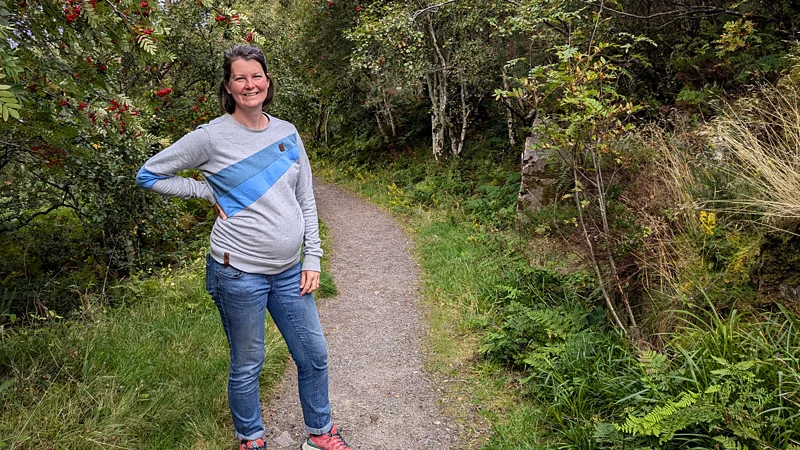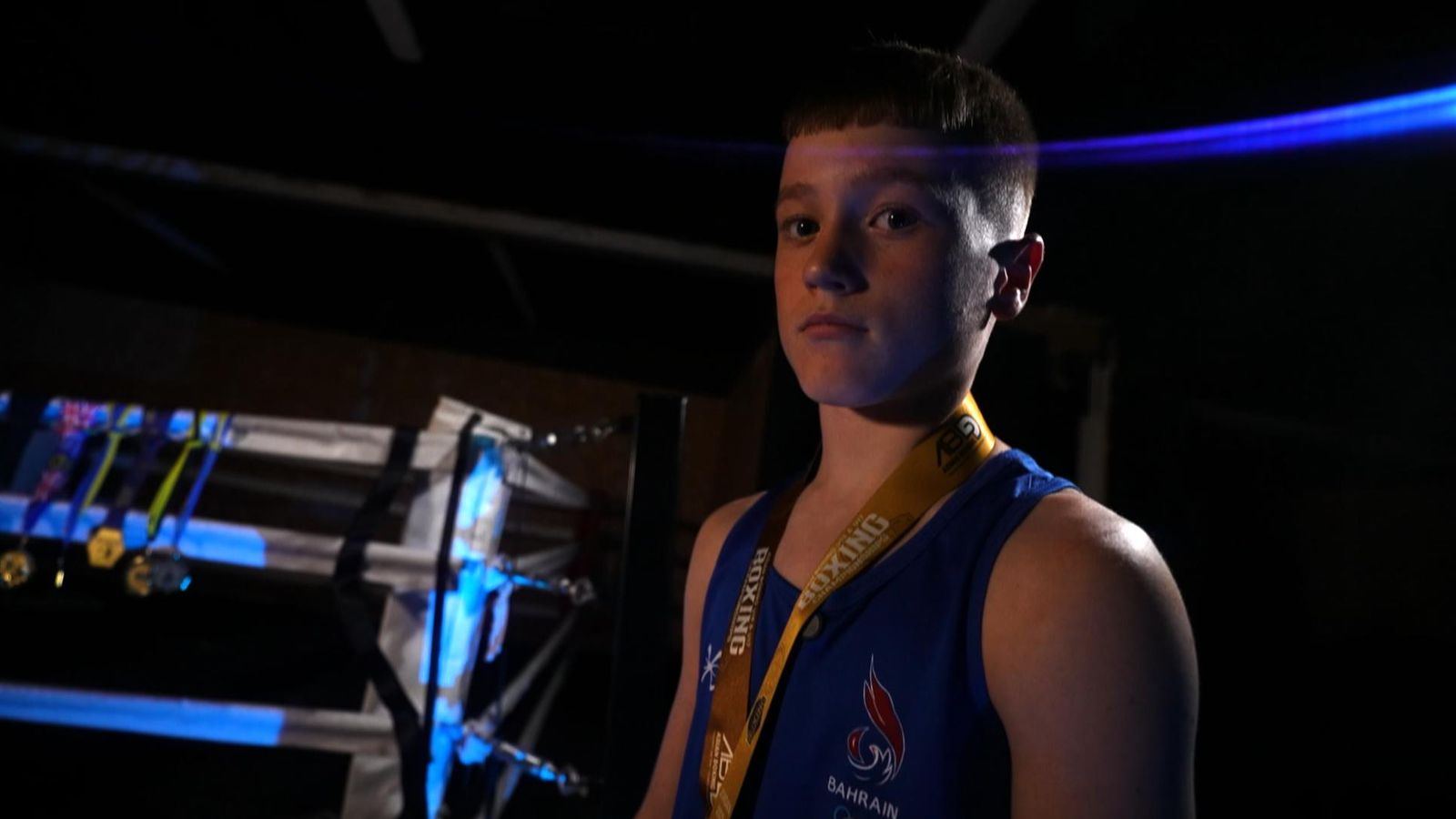The rewilded Scottish golf course turned into a nature 'microcosm'
From Scotland to California, golf courses are being rewilded – with lofty aims to benefit both people and nature.

Sinking into nature comes easy at the Plock of Kyle. I visit this tiny wedge of parkland on the west coast of Scotland, just across the bridge from the Isle of Skye, on a rainy day in late September, and park ranger Heather Beaton and I spend the afternoon wandering around its various ecosystems-in-miniature.
We clamber over rocks at one of its little hidden natural harbours. We freeze as black darter dragonflies land on her pink shoe by a pond. And we bend to peer at circles of huge mushrooms which have sprung up overnight in its tiny woodland.
A wildflower meadow, ponds, scrub habitat, coastline and even an area of peat bog can be found on this little 60-acre (24-hectare) plot, which boasts roe deer, otters, lizards, eels and a huge array of insects and birds. "We do describe it as a microcosm of Scotland," says Beaton. "If you think of all of the major habitats of Scotland, we've got them here on the Plock, just in miniature." It's an impression she works to cultivate. "The more little pockets we have, the more chance a person has to... end up having a nature experience," she says.
All of these habitats had fallen into serious disarray until a few years ago, says Beaton. In fact, most of this area used to be a golf course.
The Plock is part of a small but significant global trend of land once used for golf being turned back over to nature. From California to Pennsylvania and Australia to Canada, these projects are reaping in some big rewards for both biodiversity and local people.
But what does it take to rewild a golf course? Could this be a key to both supporting biodiversity and helping more people get the immense benefits that come with interacting with nature? And what do we win – and lose – in the process?
Huge swathes of land are used for golf. According to one recent study, many countries across the world, including the UK and the US, use far more land for golf courses than they do for wind or solar energy. The US has the most courses of any country by far: its 16,300 golf courses occupy an estimated 8,000 sq km (2 million acres), an area around a third of the size of Vermont.
Golf emerged as a sport in my home country of Scotland in the 15th-17th Centuries, and for a time was relatively widely played, with courses often shared spaces used for walking and other activities as well as golf. Over the last century or so, however, it has widely emerged as the sport of the most affluent in society.
Luxury hotels and golf clubs have sprung up across the world, sometimes damaging precious ecosystems in the process. In just one example, in 2017 a golf course built by now US president Donald Trump in Aberdeenshire was found by a Scottish government watchdog to have "destroyed” the sand dune system it was built on, causing permanent habitat loss and loss of its status as a site of special scientific interest (SSSI). Responding to a request for comment about these criticisms, Sarah Malone, executive vice president of Trump International, Scotland, called the reports "inaccurate and grossly misleading".
"Nature Scot [Scotland's conservation body] ignored and neglected the dunes under the previous ownership and have barely set foot on this site over the past 20 years," she said. "Their own assessment acknowledged that many attributes of the SSSI – which was, in fact, less than 3% of our vast estate – had flourished since the first golf course was completed in 2012. Trump International's ongoing investment and care of the land is beyond question, as anyone who actually visits the property will attest."
A separate proposal for an 18-hole golf course on another fragile Scottish dune sand ecosystem continues to divide public opinion.
There are other environmental impacts of golf courses alongside land use. In the US, an estimated 1.5 billion gallons (5.7 billion litres) of water a day is used to irrigate golf courses, mostly from lakes and onsite wells. Courses are also treated with some 100,000 tonnes of nitrogen, phosphorus and potash a year. Run off from these fertilisers and pesticides have been found to cause risks to humans, wildlife and the environment.
"Certainly, some of the key environmental concerns with golf over time have involved pesticide spraying, the quantity of water used, especially in times of drought, and the significant amount of land sometimes needed for a golf course," says Brad Millington, associate professor of sport management at Brock University in Ontario, Canada, and co-author of The greening of golf.
The environmental impact of golf has also developed over time, Millington adds, as humans have developed the capacity to build golf courses "seemingly just about anywhere", no matter the type of land.
Golf has increasingly become a target for environmental activists. Brazilian activists camped out on a highway in Rio de Janeiro ahead of the 2016 Olympics, to protest the city's decision to build a new course on an area of environmental protection. In 2022, climate activists in France filled golf course holes with cement to protest an exemption from water bans amidst a severe drought. In 2024, Extinction Rebellion activists disrupted the Travellers Championship, a golf competition in Connecticut, spraying coloured smoke and powder and sporting t-shirts reading, "No golf on a dead planet".
Some anti-golf movements completely reject golf, a view that's become common to see on social media in recent years. But the overall impact of any individual golf course depends on a huge array of factors, says Millington: the amount of non-recycled water and pesticides used in maintenance, for example, and what was there before the golf course was built in the first place.
From an environmental standpoint, it's also worth considering what else the land might be used for. Land disused for golf can end up being developed for housing or commercial ventures. And while building housing is important for many other reasons, concreting over part of the land may well not improve the environmental profile of an ex-golf course, leading some to argue brownfield sites should be used instead.
During the decades that the Plock was a golf course, meanwhile, some of its natural habitats remained. Most of the woodland here is natural, and the peat bog, while deliberately drained by golfers, also survived, based on the depth of peat, which accumulates very slowly, Beaton estimates it could be over 1,000 years old.
Previously used for farming, the Plock was never a high-end golf course: it first opened for the community in the 1920s by the local lord and lady, says Beaton, and after various ups and downs the course eventually petered out in the mid 2000s. For a time the land was left largely to its own devices. In 2019, the trust which owned the land passed it to the local Kyle of Lochalsh Community Trust, which opted for it to become parkland. "It was just overgrown and abandoned and just unloved, really severely unloved," says Beaton. "A lot of effort has gone into bringing it back."
The main green, previously kept short and highly manicured for golf, had become a dense area of tussocky grass. Now it is managed as a permanent wildflower meadow with over 80 species of flowering plant, from native orchids to pignuts and goldenrods, and heaves with butterflies and other insects. "In the height of summer, it is just beautiful. It's absolutely beautiful," says Beaton.
Many of the golf tees, meanwhile, have been reclaimed by scrub and will, in time, naturally become woodland, says Beaton. Fresh water is being brought back, supporting its new otter population. The peatland is being rewetted, a measure which can stunt carbon emissions and bring back species.
Beaton, who is in her mid-30s, clearly has an unbridled affection for the Plock. She grew up on a farm in the Scottish borders and previously worked as a warden on Uist in the Outer Hebrides, before moving to Kyle of Lochalsh in 2021 to start work as one of the Plock's two rangers. "We just work away to make it as good a place as possible for all the visitors and users, whether human or wildlife," she says.
The struggle, as always, is money. The transformation of the Plock has largely been supported by grants. The trust has explored other options: charging for scything training, a secondhand shop and community facilities, including a laundrette it runs in the village. But it will need something larger scale to become self-sustaining, says Beaton: likely some kind of onsite tourist accommodation. It also hopes to build a traditional-build longhouse to use as a small museum, ticketed for tourists. "I think the sustainable income is going to be the big challenge," says Beaton. "How we approach that, how we develop that, that is going to be the big question."
Magical as it is, the Plock is certainly miniscule. But it's not an isolated example of an ex-golf course being repurposed for nature. Projects are springing up in Scotland, the wider UK as well as across the Atlantic in the US and Canada.
In 2018, The Trust for Public Land (TPL), a US non-profit, bought the 157-acre (64-hectare) San Geronimo Golf Course in California and set about creating a new commons and restoring its wildlife and streams. At the time, the golf course was likely one of the top 10 water users in Marin County, says Erica Williams, who led the TPL's work on the park.
San Geronimo Golf Course was a "once-in-a-lifetime opportunity to create a climate-resilient ecosystem", says Williams, by reconnecting the property's creeks and waterways as well as recreating its historic floodplain.
The trust opened pathways to the public and stopped irrigating the land. It worked with partners to restore the ecosystem of the endangered coho salmon. "The 2024 spawning season brought record numbers of spawning salmon to the San Geronimo Valley watershed, particularly to Larsen Creek," says Williams. Hundreds of species have been spotted in the park: everything from deer, coyote and bobcats to native egrets, ducks and hawks, along with dozens of native plant species.
While some people did experience the loss of the golf course, many residents and users have expressed "their deep gratitude for this beautiful now publicly accessible landscape", says Williams. "Overall, the public reaction has been quite positive," she says.
In August 2024, the TPL transferred ownership of the San Geronimo Golf Couse, now known as the San Geronimo Commons, to the local government, including land set aside for a future fire station. The TPL has used a similar model of restoration and transfer to public ownership with several other golf courses, usually ones that were becoming financially unviable, says Williams.
In fact, snapping up golf course land for rewilding in the US makes a lot of sense, because the land covered by golf courses has been decreasing for decades, falling by 12% between 2005 and 2021. "Given the climate crisis, there's a good case to use [this land] to address problems such as biodiversity loss," says Millington.
Golf course properties are often large, adds Williams, and by design often built within larger natural landscapes near natural features, such as creeks and streams. "They are often relatively flat, with cart paths and trails that allow for public access." Long broad golf course airways can present a unique opportunity for wildlife corridors, she adds. Plus, they tend to consume a lot of water, meaning rewilding can help with significant water conservation.
Of course, closure is not the only way to bring nature back into golf courses. In some cases, the TPL has saved golf courses that were otherwise set for closure, and worked to open up the game to everyone while also managing the land in a way that works for wildlife. On many actively used golf courses around the world, greenskeepers are making efforts to manage the land to better support nature, which is often cheaper too.
In fact, in the US fertiliser and water use in golf have substantially decreased in recent decades – in part due to course closures, but largely due to management changes.
Naturalised areas, sections of the golf course that aren't so heavily maintained, have also been on the rise. In 2015 survey, 46% of US golf courses said they had increased the land dedicated to naturalised areas over the past decade, with just 5% saying they had decreased it.
"This can be done to reduce maintenance costs but there can be an environmental angle as well, such as enabling wildlife to flourish," says Millington.
However, while many golfers support wilding efforts on non-play areas, there can be trade offs in terms of playability of having more dense vegetation around.
Golf courses that are being made a little wilder can offer lessons for other types of land as well. "I do think there's ways of introducing nature into manicured landscapes,” says Beaton. "You can do it in cities, you can do it in any sort of any land."
Because ultimately, what managers of many rewilded golf courses tend to emphasise is the benefit to local people. At San Geronimo, people from across the San Francisco Bay Area come to hike, bike, walk their dogs and ride horses, says Williams. "One thing that is absolutely wonderful to see is the multigenerational use, made possible by the property's gentle terrain. I've seen family members, young and old, walking together on the land."
At the Plock, nestled helpfully close to the town of Kyle of Lochalsh, paths now wind through the tightly knit ecosystems, many of them disabled-friendly. The Plock runs guided walks, a mental health support group and scything classes (useful for locals with big gardens or crofts who want to cut away overgrown bracken).
It also hosts groups of local schoolchildren, who sometimes help with restoration efforts. "If you can imagine little nursery kids, so you're talking three, four year olds coming along and planting a wee tree with a spade," Beaton says of one recent visit. "And then I had to come back afterwards and just make sure they were properly in the ground. But you know, they did that. When they're 20, this is going to be a woodland."
Leaving the Plock after my walk with Beaton, I meet William Roe, a local who comes here to walk his two Hungarian vizsla dogs almost every day. I ask him whether it’s a shame to have lost the golf course, but he shakes his head. "You can make a golf course in lots of places… but you can't make something like this." There are oak trees here, he adds, that are more than 200 years old. "And that just tells you that this place has been special for a long time, and I hope it will be forever more," he says.
-BBC







